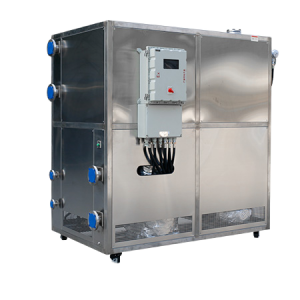water cooled heat pump chiller
Water-Cooled Heat Pump Chillers: Efficient HVAC Solutions for Sustainable Buildings
Water-cooled heat pump chillers are innovative HVAC systems that harness the power of water as a heat source or sink to provide heating and cooling for buildings. These systems are increasingly popular due to their energy efficiency and environmental benefits.

Operational Principles
Water-cooled heat pump chillers operate based on the principle of transferring heat through a refrigeration cycle. They use water from sources like wells, lakes, or the ocean, which acts as a heat exchanger. During the cooling mode, the system absorbs heat from the building and releases it into the water source. In heating mode, the process is reversed, extracting heat from the water to warm the building.
Components of a Water-Cooled Heat Pump Chiller System
The main components of a water-cooled heat pump chiller include:
Compressor: Compresses the refrigerant, raising its temperature and pressure.
Condenser: Releases heat from the refrigerant to the water source.
Evaporator: Absorbs heat from the building in cooling mode and adds heat in heating mode.
Expansion Valve: Regulates the flow of refrigerant to the evaporator.
Heat Exchanger: Facilitates the transfer of heat between the refrigerant and water.
Benefits of Water-Cooled Heat Pump Chillers

Energy Efficiency: They provide efficient heating and cooling with lower energy consumption compared to traditional HVAC systems.
Environmental Sustainability: Reduce carbon footprint and environmental impact due to minimal greenhouse gas emissions.
Reliability: Water sources offer a consistent temperature, leading to reliable system performance.
Versatility: Suitable for a wide range of applications, including commercial, industrial, and large-scale residential buildings.
Applications
Water-cooled heat pump chillers are used in various applications, such as:
Commercial Buildings: Office spaces, shopping centers, and hotels.
Industrial Facilities: Manufacturing and processing plants requiring stable temperature control.
District Heating and Cooling: Providing thermal energy for heating and cooling across a community or district.
Selection and Design Considerations
When selecting a water-cooled heat pump chiller, consider factors like:

Water Source Availability: Assess the feasibility and sustainability of the water source.
Climate Conditions: The local climate affects the system’s performance and design requirements.
System Capacity: Ensure the system’s capacity meets the building’s heating and cooling demands.
Energy Efficiency Ratio (EER): Look for systems with high EERs to reduce operational costs.
Environmental and Regulatory Compliance
These systems should comply with environmental regulations and best practices, including the use of environmentally friendly refrigerants and energy-saving technologies.
Conclusion
Water-cooled heat pump chillers offer a sustainable and efficient solution for HVAC systems in various applications. Their ability to utilize natural water sources for heating and cooling contributes to energy savings and reduced environmental impact. By understanding their operational principles, benefits, and design considerations, building owners and engineers can make informed decisions to enhance the sustainability and efficiency of their HVAC systems.
This article provides a comprehensive guide to water-cooled heat pump chillers, covering their operational principles, components, benefits, and applications. It emphasizes the importance of selecting the right system based on water source availability, climate conditions, and energy efficiency, ensuring users can optimize their HVAC systems for performance and sustainability.
 LNEYA Thermal Test Chillers
LNEYA Thermal Test Chillers





HelloPlease log in